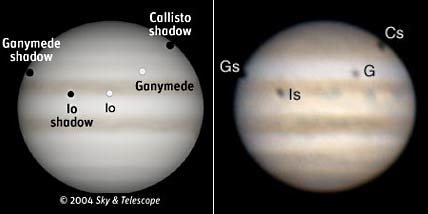
Left: This is how Jupiter was expected to look at 8:10 Universal Time on March 28, 2004. Right: This webcam image shows the appearance of Jupiter at 8:04 UT on the 28th. Gu Yu of Morgantown, West Virginia, captured the scene with Jupiter just 25° above the horizon. The shadows of Ganymede, Io, and Callisto are labeled Gs, Is, and Cs respectively, while Ganymede is labeled simply G. Click above to see a four-image sequence showing Io entering Jupiter’s disk and then becoming invisible. North is up.
Courtesy Gu Yu.
Clouds and poor seeing plagued much of North America on the night of March 27–28, 2004. Nonetheless, many people stayed up to observe the remarkable triple-shadow transit on Jupiter, an event that happens roughly once every decade. From 8:00 to 8:19 Universal Time on the 28th, two moons and three shadows lay on Jupiter’s disk.
Seeing all three shadows at once proved to be quite difficult because Callisto’s shadow started to slide off Jupiter’s disk shortly after Ganymede’s shadow was fully in place. The forecast called for both shadows to lie on Jupiter simultaneously for 19 minutes, but that referred to the shadow’s centers. The shadows are fairly large, and it takes several minutes for them to traverse their own length. They also can be rather hard to see when they lie on the planet’s limb.
In compensation, Ganymede’s grey disk stood out unexpectedly well because it lay in front of the North Tropical Zone, which is particularly broad and bright right now. Io transited in front of the North Equatorial Belt and became nearly invisible shortly after it entered the disk.
 0
0
Comments
You must be logged in to post a comment.